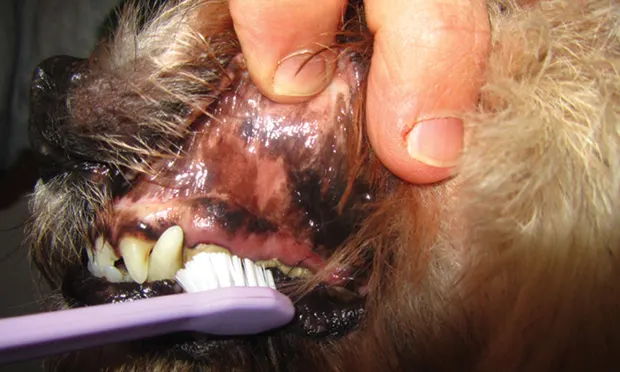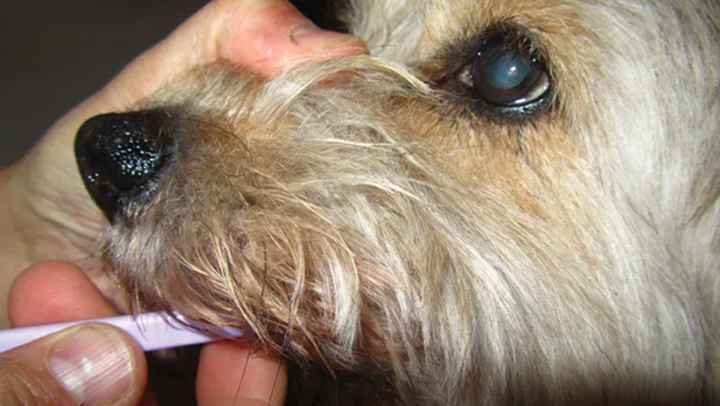Top 5 Tools & Techniques for Oral Home Care
Brook A. Niemiec, DVM, DAVDC, DEVDC, FAVD, Veterinary Dental Specialties & Oral Surgery, San Diego, California

Bacterial plaque can colonize the surface of a tooth within 24 hours of cleaning. Adequate home care is necessary to prevent the rapid recurrence of inflammation and progression to periodontal disease.1-7 Without proper home care, periodontal pockets can become recolonized within 2 weeks of dental prophylaxis and can return to pretreatment depths within 6 weeks of therapy.5 Supragingival plaque and calculus have negligible effects on periodontal disease development or progression; however, plaque located at the gingival margin and the subgingival area results in inflammation and subsequent periodontal disease.8-10 Maintenance of periodontal health depends on plaque control at and below the gingival margin.
1. Toothbrushing
When performed properly and regularly, toothbrushing is the most effective defense against plaque,11 but only an estimated 1% of clients brush their pets’ teeth daily.12 Daily brushing is optimal to slow plaque formation (see Toothbrushing: Materials & Methods); brushing every other day is not as effective for gingivitis control.1,13,14 Three times a week has been suggested as the minimum acceptable frequency for patients with good oral health, while pets with periodontal disease should have their teeth brushed daily (see Toothbrushing Compliance Tips).1,13-17
Toothbrushing Compliance Tips22
Start early. Younger pets are more likely to accept active home care.
Go slow. Start by holding the pet’s mouth and placing a finger in the mouth, progressing to teeth brushing.
Be consistent. Toothbrushing is a learned behavior.
Provide positive reinforcement. Use rewards (treats, food, or affection) to increase the likelihood of acceptance.
2. Antiseptic Solutions
When performed properly and regularly, toothbrushing is the most effective defense against plaque,11 but only an estimated 1% of clients brush their pets’ teeth daily.12 Daily brushing is optimal to slow plaque formation (see Toothbrushing: Materials & Methods); brushing every other day is not as effective for gingivitis control.1,13,14 Three times a week has been suggested as the minimum acceptable frequency for patients with good oral health, while pets with periodontal disease should have their teeth brushed daily (see Toothbrushing Compliance Tips).1,13-17

3. Chew-based Treats & Diets
Numerous products are available that purport to decrease dental disease in dogs and cats, but many are not effective. Careful evaluation of product research is the best clinical course for practitioners. The Veterinary Oral Health Council (VOHC), a group of board-certified veterinary dentists, is an invaluable resource for practitioners. The VOHC evaluates relevant research and awards a seal of acceptance to products meeting a series of requirements. Tartar control diets can decrease tartar and plaque buildup.39 Although dry dog food alone was previously believed to be beneficial for oral health, it has not been shown to be superior to canned foods.40,41 Prescription diets that contain abrasives to scrape plaque from the teeth, larger kibble sizes to increase chewing time, and calcium chelators should be considered to further decrease dental calculus.42-45 Many of these products have received the VOHC seal as effective reducers of tartar and plaque. These diets are typically ineffective for gingival margin; greatest efficacy is noted in the areas around the cusp tips.46 One diet has been clinically proven to decrease gingivitis, attributable to fiber arrangement within the dry kibble.47-49 Tartar control treats are used in passive home care. Although plain biscuits have not been associated with a reduction in periodontal disease,50calcium-chelator–coated biscuits appear to be a better choice, but even these are not particularly effective.51 Several new edible treats have shown varying efficacy. Many are untested; however, several treats have VOHC approval. Rask and rawhide chews are also available for passive home care.52,53 Similar to tartar control diets, abrasives clean the tooth surface, and calcium chelators or other substances (eg, chlorhexidine) further increase antiplaque efficacy.54 A handful of these products have been clinically proven to decrease dental disease, and several have received VOHC approval.51,52,55-59 Chew treats with the claim of dental disease control are often hard in texture and may result in tooth fracture. If a fingernail indention can not be made in the product, it is too hard to chew safely. Products that are effective for dental disease are not always safe for pets. Clients must be aware of potential choking or obstructive hazards, and the VOHC has included evidence of safety in its general requirement.
Brush Up on Plaque Control
Active and passive plaque controls are the primary components of dental home care. Active methods require the participation of the owner with activities like rinsing or toothbrushing. Passive methods include treats or prescription dental diets to enhance chewing behaviors.
Active home care is most beneficial for mesial (front) teeth, while passive is more effective for distal (back) teeth.18,19 Toothbrushing compliance rates drop to approximately 50% after 6 months, even among motivated pet owners.20 Compliance is more likely with passive home care, which is important because long-term consistency is necessary for efficacy of dental home care.21 Passive home care may be more effective than active, likely because of regular compliance.
4. Barrier Sealants
Two barrier sealants are currently available. One product alters the electrostatic charge of the teeth and prevents plaque attachment through the creation of a hydrophobic surface on the teeth.63,64 Professional use (but not home care) of this product is supported by clinical evidence.50
5. Water Additives
This is a fairly novel area of veterinary dental home care. Some studies in humans have shown efficacy of active ingredients, but there is no peer-reviewed clinical evidence to support their use in veterinary periodontal treatment.29,65 A xylitol-containing product was shown to decrease plaque and calculus in a single study; however, potential negative systemic effects (eg, hypoglycemia, liver derangement) are possible and should be weighed against possible oral benefit.66 A different product notes that unpublished data support its use for plaque control; the product has been accepted by the VOHC.67
Closing Thoughts
Home care is an important but often-neglected aspect of periodontal therapy. Consistent and early client education is integral for compliance. Although numerous options are available, toothbrushing remains the standard of care. Only a few passive methods of dental home care have proven efficacy, and veterinarians are encouraged to critically review clinical studies before endorsing home care products.
Toothbrushing: Materials & Methods
Brushes
Multiple veterinary brushes are available, although a soft-bristled brush designed for humans can be substituted.
Mechanized brushes have superior effects in human studies.61,62
Pastes
Veterinary toothpastes can increase acceptance by the patient. These toothpastes typically contain a calcium chelator to decrease the level of calculus43-45; calculus alone is largely nonpathogenic,1 reducing the role of the paste in plaque and gingivitis control.
Baking soda–based toothpastes and other human oral health products are not recommended, because they contain detergents or fluoride that may cause GI upset or fluorosis if swallowed.1,13
Antimicrobial preparations
These can improve plaque and gingivitis control and may be useful in patients with established periodontal disease.24-29